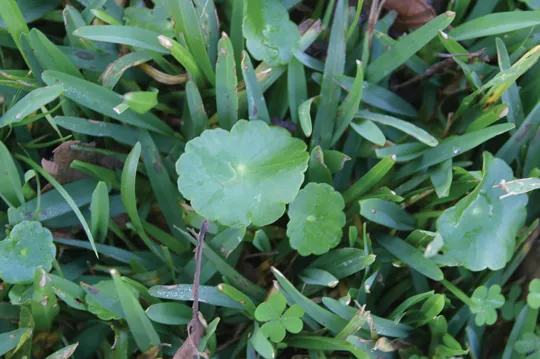Weeds are simply defined as plants out of place, or anything growing where it wasn't wanted. Technically, St. Augustine grass can be a weed in a Zoysia lawn, or vice versa. Here is a list of the most common Gainesville lawn weeds that can be found in our area.

Yellow Woodsorrel – Oxalis stricta
Annual to short-lived perennial, upright, with a single taproot, spreads by seed. Leaves of three, heart-shaped, pale green and bitter to taste due to the presence of oxalic acid. Bright yellow flowers have five petals. Prolific seed producer, pods will scatter seed for several feet when touched.
 Bull Thistle – Cirsium vulgare
Bull Thistle – Cirsium vulgare
Bull thistle is a biennial growing into a rosette with large, fleshy, coarsely-toothed spiny leaves. The second year, a woody, flowering stalk produces a few, rose-purple blossoms. Produces less flowers than Canada Thistle but all flowers are fertile.
 Quackgrass – Agropyron repens
Quackgrass – Agropyron repens
Blue-green rough bladed perennial reproducing by seed and aggressive rhizomes. Erect stems leaves rolled in bud, sheaths hairy. Short membranous ligule, large, very prominent clasping auricles. Spike seed head resembling perennial ryegrass. Spreads throughout lawn and from ornamental beds. Very difficult to control.
 Broadleaf Plantain -Plantago rugelii / Plantago major
Broadleaf Plantain -Plantago rugelii / Plantago major
A perennial rosette reproducing from seed. Leaves are large, rounded and deeply veined with wavy edges and purple petioles. Seed stems resemble a rat’s tail and support small flowers and seeds. Long tap root, similar to Dandelion, increases plants’ hardiness to stress and herbicides
 Crabgrass – Digitaria sp.
Crabgrass – Digitaria sp.
Several species that are true annuals. Peak germination by early summer. Yellow green leaves rolled in the bud with hairy edges, coarse-textured, broad collar, membranous liguile and hairy sheath. Blade flat with a sharp point. Seed head composed of three to ten finger like racemes or spikes, may appear purple to tan in color. Plant declines after seeding with shorter days. Eliminated by frost. Occurs all over the U.S., although less in the North than in Gainesville lawns
 Dandelion – Taraxacum officnale
Dandelion – Taraxacum officnale
Perennial with long taproot produces by seed. Stems short arising from a rosette bearing oblong, lobed, narrow leaves. Large yellow flowers mature into round puffballs full of seed distributed by wind for miles. Mostly germinates during late summer.
 Goosegrass – Eleusine indica
Goosegrass – Eleusine indica
Annual forming rosette of flat stems, usually silvery at center. Leaves are folded in the bud with overlapping sheaths. Membranous ligule with sparse hairs on collar. Seed head forms two to ten finger-like spikes, zipper like, much broader than crabgrass. Germinates later than crabgrass. Persists under close mowing, even on putting greens.
 Nutsedge - Cvperus esculentus (yellow) Cvperus rotundus (purple)
Nutsedge - Cvperus esculentus (yellow) Cvperus rotundus (purple)
Also known as nutgrass, but is not a grass. Perennial, reproducing by seeds and nut-like tubers on roots. Stems erect triangular. Leaves 3-ranked, narrow, grass-like basal. Seed on unmowed plants arranged in narrow spikelets on umbel like inflorescence. Yellow nutsedge has single fleshy tubers on ends of roots. Purple nutsedge has strings of tubers on wiry rhizomes.
 Pennywort: ( Dollarweed ) - Hydrocotvle sp.
Pennywort: ( Dollarweed ) - Hydrocotvle sp.
A perennial growing from rhizomes, tubers and seed. Erect leaves with scalloped margins on a long petiole in the center of an umbrella-like leaf. Found in moist to wet sites. Most common in Transition Zone, South.
 Spurge - Euphorbia maculate, E. supine
Spurge - Euphorbia maculate, E. supine
A summer annual that begins germination from seed when soil temperatures reach 85° F and continues all summer long. Small, oval, opposite leaves vary from dark green to red with a brown blotch on the upper surface. Reddish low growing stems, that fan out from the taproot, form a dense mat. Milky sap is sticky. Prolific seed producer, several thousand from one plant. Plant matures in a matter of days in hot weather.
 Matchweed – Phyla nodiflora
Matchweed – Phyla nodiflora
Matchweed is a mat-forming perennial with opposing leaves on hairy branching stems. Leaves have small teeth at the outer tip. The purple to white flowers emerge around the tip of the seed stalk forming a match-head appearance. Matchweed spreads by both seeds and stolons along prostrate stems.


